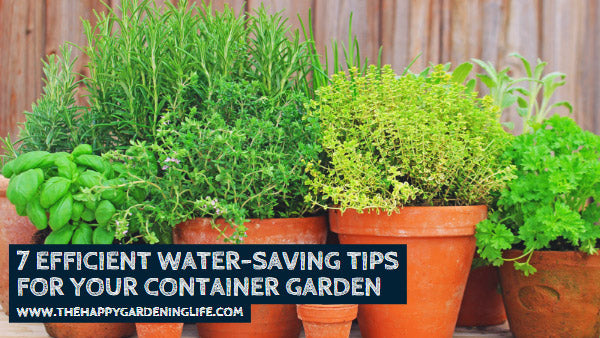
7 Efficient Water-Saving Tips for Your Container Garden
Share
 Every plant needs water for survival, but giving more than what’s needed can create great damage especially to your container garden. Not only is overwatering known to lessen the nutrients in your soil and cause your plants to wither, it’s also very wasteful to the environment.
Every plant needs water for survival, but giving more than what’s needed can create great damage especially to your container garden. Not only is overwatering known to lessen the nutrients in your soil and cause your plants to wither, it’s also very wasteful to the environment.
So how can you water your container garden in the most effective and efficient way possible?
Well first of all, one has to select garden pots properly. Refrain from using dark-colored pots and porous pots like terracotta because they can decrease moisture, dry your soil, and damage the roots of your plants.
Another way to preserve water is to use the self-watering method. You can do this by setting up an irrigation system around your container garden, or by using upturned bottles with holes on it. This way, the plants can receive the right amount of water without wasting any.
To get more water-saving tips for your container garden, check out these 7 efficient methods below. Don’t forget to share this blog post with your fellow gardeners on Facebook, Twitter and Pinterest!
Conserve More Water for Container Gardening in 7 Efficient Ways
1. Choose pots wisely to minimize moisture loss. Avoid porous planters like terracotta or coconut/coir fibre liners in hanging baskets. These materials leach nutrients and moisture more rapidly than glazed ceramic pots and solid stone. Dark colours like black, and metal containers heat up quickly. They provide little insulation, causing the potting soil to dry out faster and increase the possibility of root damage. If you have dark coloured pots, try positioning in a shady spot with shade-loving edibles. Locate your light coloured, non-porous pots in full sun areas.
2. Use self-watering containers that slowly ‘wick’ moisture up from the bottom. You can also install drip irrigation or upturned bottles (with holes in the lid). These systems trickle water into your planter, so there’s no waste or over-watering. Water spikes are another option. They direct moisture into the root zone where your plants need it most.
3. Build healthy living soil. Plants living in a microbially-active, nutrient-rich soil are stronger, having all their mineral needs met. Add organic matter like compost, microbes, worm castings and minerals.
4. Select short-season crops. They mature faster and require less water and energy to grow. The ‘Days to Maturity’ on a seed packet or catalogue will help you choose wisely. Try rocket/arugula, loose leaf lettuce varieties, radish, baby spinach, Asian greens, pea shoots, spring onions and bush beans.
5. Choose easy-to-maintain, low-water needs edibles like sprouts, microgreens, rosemary, garlic chives, garlic, nasturtiums, chard, Malabar or New Zealand spinach, bush beans, pineapples, Italian flat leaf parsley, sage, oregano, marjoram and thyme. Look for the terms “drought tolerant” or “drought resistant” food crops on seed packets and in catalogues.
6. Prune unnecessary growth. Plants with lots of large leaves are prone to losing moisture. They transpire (lose water) through the pores or stomata on the underside of their leaves.
7. Time your watering. Water when the air is still and early morning, when temperatures are cooler. Water evaporates from the soil surface more quickly later in the day, when the air is hot and dry. Watering in hot or windy weather = increased evaporation. Vegetables also tend to require more water on sunny days with low humidity.
Article Source: themicrogardener.com
